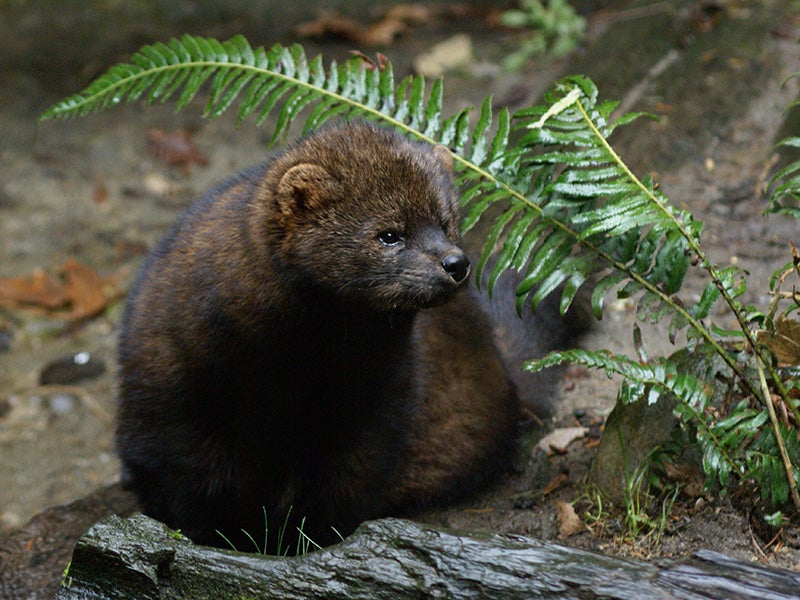Lawsuit Filed Over Feds’ Denial of Endangered Species Protection to Pacific Fishers
Rare mink-like carnivore threatened by logging, poaching, poisoning
Contact
Four conservation groups filed suit today in U.S. District Court challenging the U.S. Fish and Wildlife Service’s unexpected decision in April to deny Endangered Species Act protection to Pacific fishers.
Closely related to minks, martens and wolverines, Pacific fishers are severely threatened by logging, use of toxic rodenticides by illegal marijuana growers and incidental capture in fur traps. Although the Service proposed federal protection for the fisher in 2014, the agency reversed course and withdrew the proposal in 2016 even though the fisher’s poor status remained largely the same.
The decision to deny protections to the Pacific fisher is the latest in a string of politically motivated decisions from the Fish and Wildlife Service, in which regional staff overruled decisions by Service biologists to protect species. In December 2015, conservation groups filed a lawsuit against the Service for inexplicably denying protection to Humboldt martens, another rare West Coast carnivore on the brink of extinction. In April 2016, a federal judge in Montana criticized the Service for bowing to political pressure in illegally reversing a proposal to protect the estimated 300 wolverines remaining in the lower 48 states. And in June, the groups filed notice of their intent to bring today’s suit against the Service over its failure to protect the Pacific fisher.
“We first petitioned for protection of fishers more than 20 years ago,” said Noah Greenwald, endangered species director at the Center for Biological Diversity. “It’s a travesty that after finally acknowledging the precarious status of the fisher in 2014, the Fish and Wildlife Service bowed to the timber industry and declined to protect these beautiful carnivores.”
U.S. Fish & Wildlife Service
West Coast Distinct Population Segment of fisher (historical range and 2004 Finding range boundary). View larger map
Fishers once roamed from British Columbia to Southern California, but due to intense logging and trapping, only two native populations survive today: a population of as few as 100 fishers in the southern Sierra Nevada and another small population in the coastal mountains of southwestern Oregon and northwestern California. Fishers have also been recently reintroduced in the northern Sierra, southern Cascades and Washington state, but it is unknown whether these new populations are sustainable.
“Science, not politics, should determine whether a species deserves protection,” said Tom Wheeler, program director at the Environmental Protection Information Center. “We are excited for our day in court to show that the U.S. Fish and Wildlife Service bent over backwards to appease industry interests that would prefer the fisher go extinct.”
The Center for Biological Diversity first petitioned to protect the fisher in 1994, and again in 2000, along with the three other groups on the lawsuit filed today. Rather than provide protection, the Service added the fisher to a candidate list in 2004. In 2011 the Center reached a settlement agreement with the Service requiring a protection decision for the fisher in 2014, when it was proposed for protection as a “threatened” species. But the Service abruptly withdrew its proposed rule in April of this year.
Timeline
1994
Petition filed to protect fisher.
2000
Second petition filed.
2004
Fisher added to the candidate waiting list. (Service determines fisher warrants protection but is precluded by higher priority species.)
2010
Lawsuit filed over delay in protecting the fisher. (Service agrees under subsequent settlement decision to issue a decision.)
2014
Service announces proposed rule that would have protected fishers as a “threatened” species.
April 2016
Service abruptly withdraws proposed rule.
Today
Lawsuit filed challenging the decision to deny protections.
“It’s gotten to the point where no amount of scientific evidence is ever enough for the Fish and Wildlife Service,” said Earthjustice attorney Greg Loarie, who filed the lawsuit on behalf of the conservation groups. “At the rate we’re going now, Pacific fishers will be extinct and the Service will still be debating the extent to which the species can survive in a clearcut.”
“The Klamath-Siskiyou Mountains have the potential to be a key refuge for this imperiled species, yet the BLM recently committed itself to a land-management plan that dramatically increases logging and road building throughout Pacific fisher habitat. Without protections from the Endangered Species Act federal timber planners may drive this rare species into extinction,” said George Sexton, conservation director for the Klamath Siskiyou Wildlands Center.
Filing the suit are the Center for Biological Diversity, Environmental Protection Information Center, Klamath-Siskiyou Wildlands Center and Sierra Forest Legacy. They are represented by Earthjustice.

Additional Resources
About Earthjustice
Earthjustice is the premier nonprofit environmental law organization. We wield the power of law and the strength of partnership to protect people's health, to preserve magnificent places and wildlife, to advance clean energy, and to combat climate change. We are here because the earth needs a good lawyer.